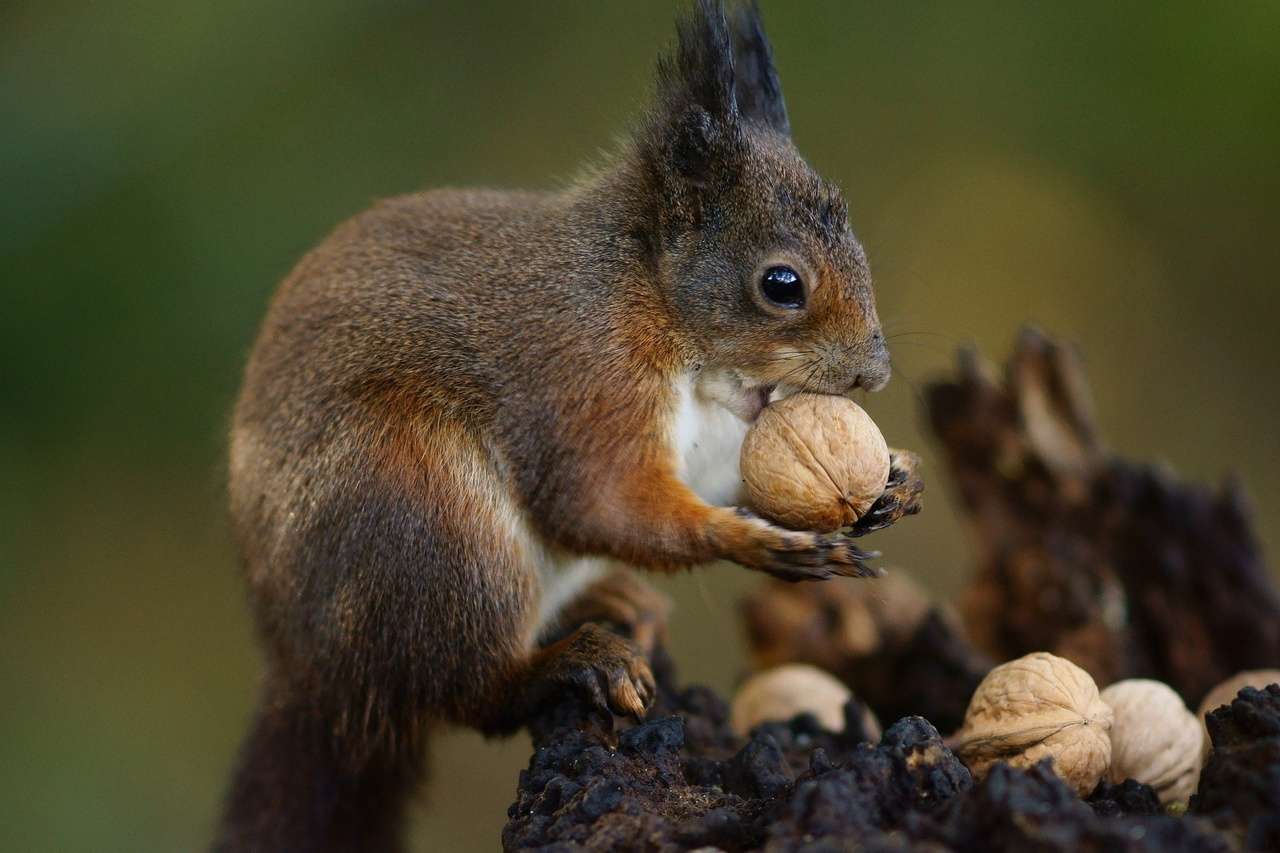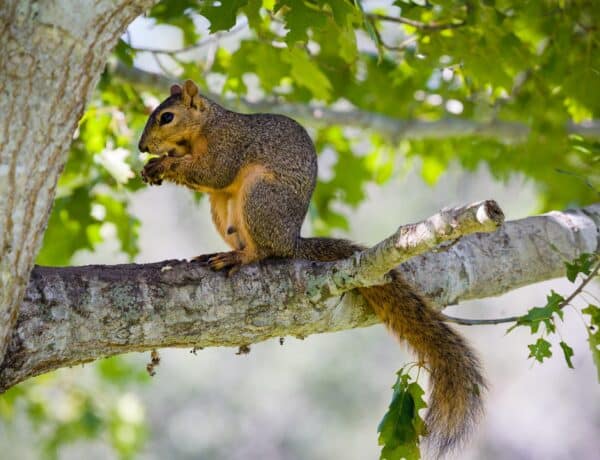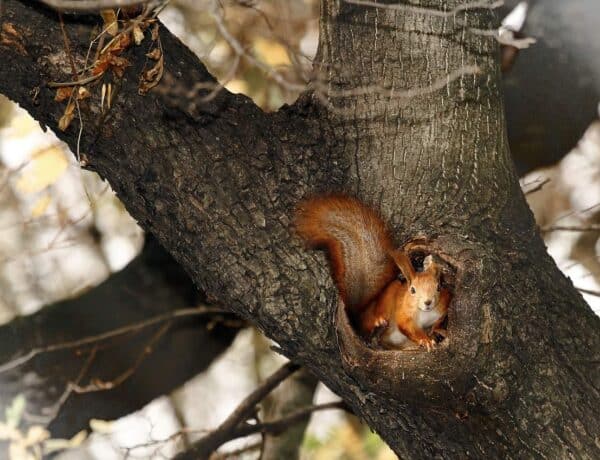Introduction
Do Squirrels Lay Eggs: Squirrels are mammals, and like all mammals, they give birth to live young rather than laying eggs. Mammals are characterized by several key features, one of which is their reproductive strategy. Female mammals typically have specialized reproductive organs that allow them to carry their offspring within their bodies until they are fully developed. Squirrels, whether they are tree squirrels, ground squirrels, or flying squirrels, follow this mammalian reproductive pattern.
The female squirrel’s reproductive cycle is fascinating. In most squirrel species, mating occurs in late winter or early spring, with males actively pursuing females in a display of acrobatic agility and persistence. After successful copulation, the female undergoes a gestation period, which varies depending on the species but generally lasts around 35 to 45 days. During this time, the developing embryos are nourished and protected within the mother’s womb.
When the gestation period is complete, the female squirrel gives birth to a litter of baby squirrels, also known as kits or pups. These newborns are blind, hairless, and entirely dependent on their mother for sustenance and care. Over the course of several weeks, the mother squirrel nurses and nurtures her offspring until they are developed enough to venture out of the nest and begin exploring their surroundings.

How do squirrels give birth?
Babies are born in a nest built by the mother in the crook of a tree, made mostly of dried leaves and twigs, and it is called a drey. Squirrels will also take advantage of tree cavities or people’s homes for nesting sites if they are accessible.
Squirrels, like many mammals, reproduce sexually. Their reproductive season typically falls during the late winter and early spring months. During this time, male squirrels actively pursue females in a lively display of courtship rituals.
Gestation Period: After successful mating, the female squirrel experiences a gestation period that varies depending on the species but generally lasts for about 38 to 45 days. During this time, the female’s body undergoes significant changes to prepare for childbirth.
Nesting: As the pregnancy progresses, the expectant mother begins to prepare for the birth of her offspring by building a comfortable and secure nest, often located in tree hollows, leafy branches, or even attics in urban areas. This nest, called a “drey,” provides insulation and protection for the impending birth.
Mammary Gland Development: The female squirrel’s mammary glands undergo changes to produce milk, which will be crucial for nourishing her young after birth.
Parturition: Squirrels typically give birth to a litter of baby squirrels, commonly referred to as “kits” or “pups.” The birth process, known as parturition, usually occurs within a secluded environment inside the nest. The mother may retreat to her nest for the birth, minimizing the risk of predation.
Does squirrel have egg?
No, squirrels do not lay eggs. They give birth to live young, which are called kits or cubs. No. The only mammals which lay eggs are the echidna, which lives in Australia and Papua New Guinea, and the platypus in Australia.
Squirrels are part of the mammalian class, which includes a wide range of animals like humans, dogs, cats, and whales. One defining feature of mammals is that they have mammary glands, which produce milk to nourish their offspring. This milk is a critical source of nutrients for the developing young, and it is provided by the mother.
Live Birth: Unlike animals such as reptiles, birds, and most fish, which lay eggs, mammals give birth to their offspring in a live state. This live birth is made possible by internal fertilization, where sperm from a male fertilizes the eggs within the female’s body. The fertilized egg, or embryo, then develops and grows inside the mother’s womb until it is ready to be born.
Gestation Period: Squirrels, like other mammals, have a gestation period during which the embryo develops inside the mother’s uterus. The length of this gestation period can vary among different squirrel species but typically lasts for about 38 to 45 days.
Do rats lay eggs or not?
No. Mice or rats are mammals. They don’t lay eggs. They directly give birth to young ones.
Rats belong to the mammalian class, which includes a vast array of animals, including humans, dogs, cats, and whales. One defining feature of mammals is that they have mammary glands, which produce milk to nourish their offspring. This milk is an essential source of nutrients for the developing young, and it is provided by the mother.
Live Birth: Mammals, including rats, give birth to their offspring in a live state. This live birth is made possible through internal fertilization, where sperm from a male fertilizes the eggs within the female’s body. The fertilized egg, also known as an embryo, then develops and grows inside the mother’s uterus until it is ready to be born.
Gestation Period: Rats, like other mammals, undergo a gestation period during which the embryos develop inside the mother’s uterus. The length of the gestation period varies among different rat species, but it typically ranges from about 21 to 23 days.
Litter Size: Rats are known for their relatively large litters. Female rats, called does, can give birth to litters that typically consist of six to twelve or more offspring, depending on various factors such as the rat’s species and age.
Do squirrels get pregnant or lay eggs?
The female uses a winter drey as a maternity nest, or builds a new one. She lines it with soft material and gives birth after a six week gestation period (time between mating and birth), in March/April and perhaps again in June/July.
Squirrels reproduce sexually, and the process begins with mating. Typically, male squirrels actively pursue females during the breeding season, which varies depending on the species and location. Mating involves the transfer of sperm from the male to the female.
Fertilization: After mating, the female’s body undergoes physiological changes to prepare for pregnancy. The fertilization of eggs (ova) by sperm occurs internally within the female’s reproductive tract.
Gestation: Following fertilization, the female squirrel enters a period of gestation. This gestation period can vary among different squirrel species but typically lasts for about 38 to 45 days. During this time, the fertilized eggs develop into embryos within the mother’s uterus.
Live Birth: When the gestation period is complete, the female squirrel gives birth to live offspring. This process is known as parturition. Newborn squirrel kits are tiny, blind, and hairless, and they rely entirely on their mother for nourishment and care.
Maternal Care: Mother squirrels are highly attentive to their newborns. They provide warmth, protection, and nourishment by nursing their young with milk produced by their mammary glands. The milk is rich in essential nutrients required for the kits’ growth and development.
Do squirrels have rabies?
Small rodents (like squirrels, hamsters, guinea pigs, gerbils, chipmunks, rats, and mice) and lagomorphs (including rabbits and hares) are almost never found to be infected with rabies and have not been known to transmit rabies to humans.
While rabies can infect squirrels, it is relatively rare in these animals. Squirrels are considered to be low-risk carriers of the rabies virus. This is because rabies is primarily spread through the saliva of an infected animal, usually via bites. Squirrels are not aggressive animals, and human-squirrel interactions that result in bites are infrequent.
Transmission to Humans: The transmission of rabies from squirrels to humans is extremely uncommon. In fact, there have been very few documented cases of squirrels transmitting rabies to humans. Rabies transmission is more commonly associated with animals like raccoons, bats, and foxes.
Precautions: While the risk of contracting rabies from a squirrel is minimal, it’s essential to exercise caution around all wild animals. If you encounter a squirrel or any other wild animal that appears sick, disoriented, or behaves unusually, it’s best to avoid contact and contact local animal control or wildlife authorities to assess the situation.
Do all squirrels have nipples?
Just like people, male and female squirrels both have nipples. The difference is that male nipples are extremely small and not noticeable. Females can have a litter of up to four babies so have a total of eight nipples to nurse them all at the same time.
After giving birth to live offspring, female squirrels provide maternal care, including nursing, to their young. They nurse their babies by allowing them to latch onto their nipples, where they can access the milk produced by the mammary glands. This milk is rich in essential nutrients and antibodies required for the growth and development of the baby squirrels.
Lactation: The period of lactation, during which the mother squirrel provides milk to her offspring, is a critical phase in the early development of baby squirrels. It ensures that they receive the necessary nourishment to thrive and grow.
Lifesaving Role: Nipples and mammary glands play a lifesaving role in mammals, as they provide a direct and consistent source of nutrition for the young, which is crucial during the early stages of life when the newborns are most vulnerable.
Is squirrel bite harmful?
Squirrel bites can be dangerous if the creature has rabies. If not, squirrel bites aren’t very alarming. If you get bitten by a squirrel, make sure to do the following: Wash the wound with water and soap (the soap is optional).
The harm caused by a squirrel bite often depends on the severity of the bite. Squirrel bites can range from minor scratches or superficial bites to deeper, more serious wounds. Superficial bites may not pose a significant health risk, while deep bites can potentially result in more severe consequences.
Risk of Infection: One of the primary concerns with any animal bite, including squirrel bites, is the risk of infection. The mouths of mammals, including squirrels, contain bacteria that can be introduced into the wound during a bite. If not promptly and properly cleaned, such wounds can become infected, leading to local or systemic health issues.
Rabies Risk: While squirrels are not common carriers of rabies, there is always a very low risk of rabies transmission associated with any animal bite. If a squirrel behaves unusually, appears sick, or has erratic behavior, there might be a slightly elevated risk. However, the risk of contracting rabies from a squirrel is much lower than from animals like raccoons, bats, or skunks.
First Aid and Medical Attention: If you are bitten by a squirrel, it’s crucial to take immediate action. Wash the wound thoroughly with soap and warm water to reduce the risk of infection. Apply an antiseptic and cover the wound with a clean bandage. Seek medical attention, especially if the bite is deep, bleeding heavily, or shows signs of infection.
Can squirrels harm humans?
If you approach most squirrels, they’ll run away. However, squirrels have been known to attack children, pets, and adults. There are many documented cases of squirrels attacking and inflicting wounds. Also, while rabies is rare for rodents, it is possible for a squirrel to carry rabies.
Squirrels are wild animals, and if they feel cornered, threatened, or provoked, they may defend themselves by biting or scratching. While squirrel bites are relatively rare, they can potentially cause injury and should be treated promptly to prevent infection.
Disease Transmission: Like all mammals, squirrels can carry diseases. While the risk of contracting diseases from squirrels is low, it’s possible. The primary concern is the potential transmission of diseases such as leptospirosis, tularemia, or rarely, rabies. However, these instances are exceptionally uncommon.
Property Damage: Squirrels are known for their chewing behavior, which they use to maintain their teeth and access food. In urban areas, squirrels may cause damage to structures, electrical wiring, and gardens. This can be costly and inconvenient for homeowners.
Nuisance Behavior: Squirrels are opportunistic feeders and may raid bird feeders, garbage cans, or gardens in search of food. Their behavior can be considered a nuisance by some, particularly in urban and suburban settings.

Conclusion
The intricate reproductive cycle of squirrels, from courtship and mating to gestation and birth, exemplifies the marvel of nature’s diversity and adaptation. These small, agile creatures have adapted to their environments and developed unique behaviors and physical traits that allow them to thrive in various habitats across the globe. Squirrel reproduction is a testament to the resilience and survival strategies of these remarkable animals. Their ability to reproduce live young rather than relying on eggs provides them with the advantage of nurturing their offspring within the safety of their bodies until they are more developed and better equipped to face the challenges of the outside world.
The life cycle of squirrels serves as a source of wonder and inspiration for both scientists and nature enthusiasts alike. Observing a mother squirrel caring for her blind, hairless newborns and witnessing their transformation into agile, self-sufficient juveniles highlights the intricacies and beauty of the natural world. While the question of squirrels laying eggs may seem straightforward, it underscores the importance of understanding the diversity of life on Earth.
Each species, from the smallest to the largest, possesses its own unique set of characteristics, behaviors, and reproductive strategies that contribute to the rich tapestry of biodiversity that surrounds us. In our quest to comprehend the natural world, it is crucial to appreciate the remarkable adaptations and life histories of all living organisms, including our furry and charismatic neighbors, the squirrels. So, the next time you spot a squirrel darting through the trees or foraging on the ground, take a moment to marvel at the wonders of nature and the fascinating ways in which these mammals, like so many others, bring their young into the world.





No Comments